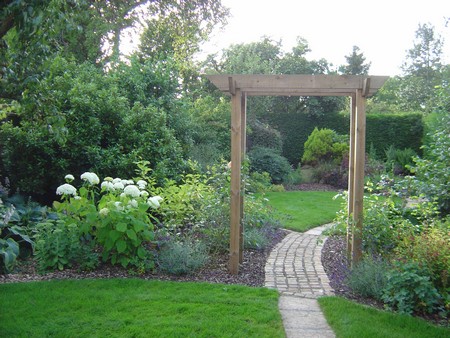One of the most common pleas which I hear from people with long, narrow gardens, is for a landscaping design which breaks up the length and makes the garden more interesting. It is usually lack of width rather than excessive length which creates the problem. This particular layout should appeal to those who prefer curves rather than straight lines. Ryan Ballheimer Landscape Design is a landscaping company St Charles.
One way of obstructing a long, narrow vista is to angle parts of the garden so that it is difficult to see from one end to the other and difficult to see all parts of the garden from one viewpoint. You may hire a commercial landscaping contractor to help you design and build you new garden. If you need landscape lighting, make sure to contact the experts for professional services.
In this example it would be just possible to see from one end to the other but, on the whole, only a proportion of the plot would be visible from, say, the French doors. By angling the patio it has meant that part of it reaches quite a long way into the lawn. It is most likely that this part of the patio at least will end up below lawn level, necessitating a shallow step up. Since the patio is crazy paving edged in brick, the step is likely to be in brick too. It will be vital to install a drain in this area to collect and take away all the rainwater which falls on the patio. In well drained soil this drain could discharge into a soakaway under the lawn. In clay soil a soakaway may not be very effective and an alternative outfall may be needed, perhaps a nearby stormwater drain.

Although width is at a premium it will be important to have adequate space against the walls and fences around the patio for climbing plants. Stepping stones often increase the burden of garden maintenance by needing some manicuring from time to time, but I felt that in this garden, they would be a useful means of linking the patio with the arch. Click Here to view the services offered by a landscaping company. It is always difficult to work out a way of arranging stepping stones so that they coincide with people’s footsteps. If you want to level the yard for your garden, you may need to use leveling drags.
I must admit to never having found the perfect arrangement but it certainly does help to increase their number or density at either end. Grass would suffer from wear and tear under the arch so I have suggested paving as a more practical idea. The arch need not be elaborate, perhaps just a heavy, horizontal wooden beam supported by two equally thick timber uprights. Second-hand beams from an old building can be particularly suitable.
The central section of the garden is mainly devoted to fruit and vegetables which, to many people, would need screening from view. Although trellis and climbers could be used, I have suggested a curved, evergreen hedge to the right of the arch, perhaps 1.5 m (5 ft) high. Unfortunately, any screen here would cast shade on the border so plants with some tolerance of shade should be chosen for just in front of the hedge. The curved grass path is quite wide — it could almost be described as a narrow lawn. If this is made too narrow it may tend to accentuate the narrowness of the garden. The border to the left of this path could feature cottage-garden flowers (herbaceous and annuals) or maybe herbs, but the conifer just to the left of the arch would ensure, along with the hedge, that the structure of the garden would remain intact throughout the winter months.
The circular lawn at the end of the garden would become a more secluded place to sit, with generous space allocated for shrubs and small ornamental trees. The little island bed in front of the shed could contain a specimen shrub or perhaps a pampas grass (cortaderia) which would help to hide the shed. In addition, the shed itself could be covered with a vigorous climber.